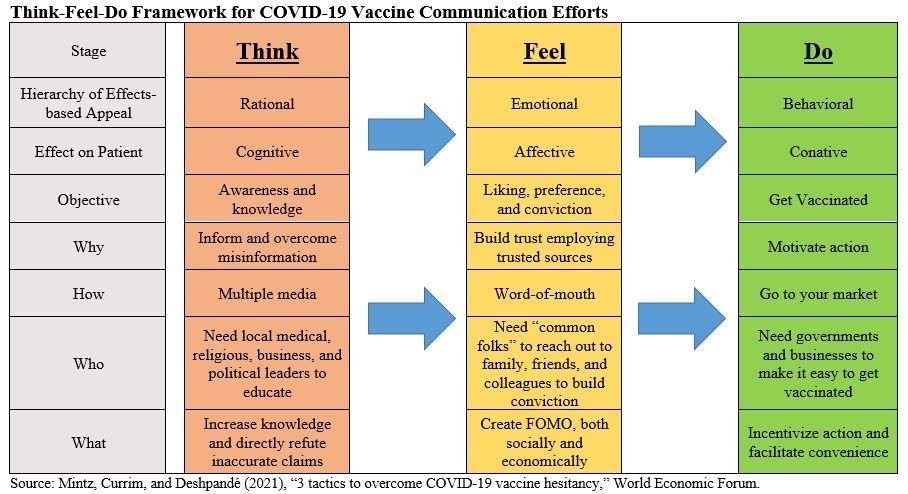This is from Klauss 'anal' Schwab & Co.'s World Economic Forum....and they say
'throw block parties' (below)
https://www.weforum.org/agenda/2021/06/3-tactics-to-overcome-covid-19-vaccine-hesitancy/An estimated 60-70% of the world’s population needs to be vaccinated against COVID-19 to achieve herd immunity. This makes overcoming COVID-19 vaccine hesitancy, procrastination, and rejection the greatest marketing communication challenge of our lifetime.
The US is moving “from a supply problem to a demand problem,” as Dr David Kessler, the chief science officer for the US government’s COVID-19 response task force noted earlier this year. Research indicates that other countries including
Australia, France, Russia, South Africa, Japan and Germany will face similar demand problems once their vaccine production and distribution issues are addressed.
There are simply not enough patient-centric solutions to address vaccine hesitancy, procrastination, and rejection. Our research focuses on creating and implementing such solutions to inform, persuade, and convince customer segments to act, and we believe this kind of approach could also boost COVID-19 vaccine communication efforts.
Patient-centric solutions to vaccine hesitancy
The decision-making process for customers - or in this case patients - is often understood using the Hierarchy of Effects Framework. It suggests that customers think first, then feel and then do. In relation to the COVID-19 vaccine, this implies that patients need to first “think” about it, that is, become aware of and knowledgeable about the vaccine. Next, patients need to “feel” positively about it, as in developing a conviction to get the vaccine. Finally, patients need to “do” it - in other words, get vaccinated.
Most policy makers have emphasised the “do” stage by focusing on distribution and convenience via a combination of mass vaccination, hospital, physician, and drug store sites. This makes sense for the population interested in getting vaccinated. For the vaccine procrastinator, hesitant, and rejector populations, however, we need to focus on the “think” and “feel” stages of decision making. Without these stages, patients are unlikely to move to the “do” stage.
Think-Feel-Do Framework for COVID-19 vaccine communication efforts
A different approach to communicating with vaccine skeptics aims to reduce procrastination and rejection.
...........how best to use this theory to eradicate vaccine hesitancy.
"1. Increase knowledge and overcome misinformation
First, we need to focus on the “think” stage by asking why people are hesitating, procrastinating, and rejecting the vaccine. Research shows a major reason is that such patients are likely to believe the invention and approval process of the vaccine was rushed, with underreported side-effects. This can be addressed by local leaders proactively reaching out and educating sceptics via media such as phone calls, direct mail, television, billboard, and digital channels.
Overcoming COVID-19 vaccine hesitancy, procrastination and rejection is the greatest marketing communication challenge of our lifetime.
More assertive approaches are also needed to overcome vaccine misinformation, in particular on social media. Previous research shows that
having medical sources directly refute inaccurate claims online is particularly effective.2. Improve feelings
The vaccine-hesitant population has developed strong feelings against it, so using information sources trusted by these people could improve their feelings about the vaccine. Research indicates those that are hesitant trust medical providers, political and faith-based leaders to provide “think”-based knowledge about medical decisions, but are more likely to rely on their communities to provide the “feel” or
emotion-based conviction for
decisions.One nurse in Louisiana deployed a particularly effective tactic. She called her vaccine-hesitant patients to talk about how she had been a vaccine skeptic but changed her mind after her husband passed away due to COVID-19.
Another way to improve vaccine sceptics’ feelings is to
play into a fear of missing out (FOMO), both socially and economically.3. Facilitate action
Mass vaccination sites are critical to facilitate patients who want to be vaccinated. Reaching people that are unsure about getting vaccinated, however, will require proactive tactics.
First, incentives can work. Several US states and cities provide cash incentives and free transportation, or create lotteries and
large block parties to incentivise vaccinations. Businesses should also be encouraged to contribute by providing paid time-off, free products and lottery giveaways.
Enhancing the convenience of getting vaccinated is another useful tactic. In business, we call this “going to your market” or, in this case, “taking the vaccine to the patients”. For example, the Primary Health Network in Pennsylvania, US created a mobile health unit to provide pop-up clinics in rural and underserved areas with larger vaccine-hesitant populations. The Southwest Health System in Colorado created
“vaccine swat teams” to reach long-term care facilities and homebound residents who experienced difficulty getting to mass vaccination sites. Such approaches provide proactive micro-vaccination
sites tailored for the vaccine-hesitant, procrastinators, and rejectors, in contrast to mass vaccination sites for those eager to get vaccinated.
We believe applying the “think - feel - do” patient-centered approach to the COVID-19 vaccine communication problem will improve efforts at accelerating
global herd immunity. Ensuring a safe economic reopening and recovery and overcoming this significant health and economic challenge could depend on such tactics."

eongoat 2 points 3.8 years ago
Come on goy, take your graphene-oxide poison, uh I mean vaccine!
count me out.